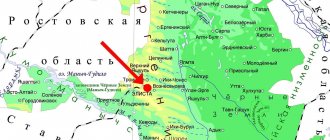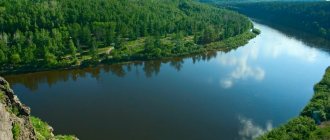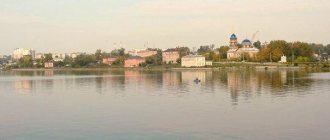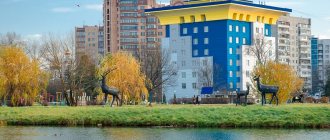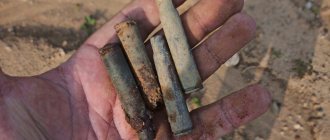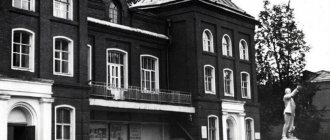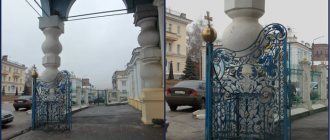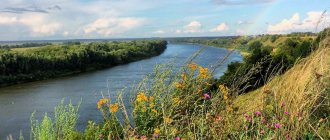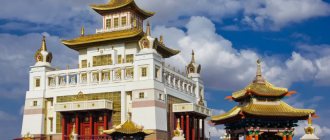Elista is the capital of Kalmykia, founded in 1865. By decree of Emperor Nicholas I in 1845, the Kalmyk steppe was afforested; forest plantations made it possible to populate these lands and form a city. Before the formation of the settlement, Kalmyks settled in these places, calling the area “Elsta”, which translated means “sandy”.
Elista has two amazing features that greatly distinguish it from other Russian cities. Firstly, the city is the Buddhist center of the country, and secondly, the World Chess Olympiad was held in the capital of Kalmykia, which the city still remembers. What exactly to see in this city, even if you only have one day, is in our description of the city's attractions.
Golden Abode of Buddha Shakyamuni
Address: Crossroads st. Ilyumzhinov and st. Lenin. Opening hours: 9.00-10.30 - general prayer service, 11.30-16.00 individual reception (except Mondays).
This is a significant temple of the Buddhist religion not only for the republic, but also for Europe. This is a bright, majestic place located in the heart of Kalmykia, with its own atmosphere and order. The temple building reaches 56 meters in height; the largest statue of Shakyamuni Buddha in Europe (12 meters) is installed inside. Services, prayers and rituals are performed in the Golden Monastery.
Enter the temple through the main southern gate. At the base of the temple, believers are greeted by the White Elder. Please note that before entering the Golden Abode it is strongly recommended to take off your shoes and put on socks; women must wear skirts.
In order for the energy of the temple to circulate correctly in the body, you need to walk around the sculptures clockwise.
Between the stairs there is a beautiful fountain, the entrance is guarded by guards - lions of unusual color, the red doors of the temple are decorated with carved gold patterns. The interior decoration of the Golden Monastery is also rich, with skillfully painted walls telling about the main events of Buddhist culture.
Memorial "Exodus and Return"
The creator of the monument was E. Neizvestny. It is installed on a mound collected from the lands of different cities of Siberia. The symbols that the sculptor combined in one composition are reminiscent of times of rise and fall. This is the memory of the Kalmyks who became victims of repression during the Stalin era. Nearby is a carriage in which people left their homeland for many years.
Location: Khrushchev street.
Golden Gate
Address: st. Lenin (you can get to the Golden Gate by minibus No. 7 coming from the city center)
In the very heart of the city is the Golden Gate - a monument of Buddhist architecture, the most recognizable landmark of Elista. The Golden Gate illustrates the life of the people of Kalmykia. The golden arch with red columns is a symbol of the sacred threshold. It is believed that when a person crosses this threshold, his soul and body are purified. Behind the Golden Gate lies a white path - a symbol of the virtuous path.
The arch has a colorful original coloring. After a person crosses the Golden Gate, he can visit the Buddhist temple and the Stupa of Enlightenment.
Transport
You can get around Elista by public transport; 19 routes pass through all city districts.
PAZ buses and Gazelle minibuses operate around the city. An interactive map with online information helps you track the movement of buses, their traffic, and their arrival at the stop. Public transport starts at 7 a.m. and ends at 10 p.m.
In 2022, the fare was 10 rubles; an increase is planned for 2022. If you use a taxi service, you can move faster and more comfortably.
There are 26 companies operating; taxis are popular:
- "Light."
- "Elite".
- "Breeze".
- "Asia".
- "Lotus".
- "Troika".
The fare is from 50 rubles. Traffic jams interfere with normal traffic only in the area of Lenin Street.
Stupa of Enlightenment
Address: Ostap Bender Avenue (you can get there by minibus No. 7 from the city center)
An architectural monument in Elista, Buddhist relics of this city are kept here. In Buddhism, it is believed that such Stupas have good power and help people acquire harmony in life, cleanse their souls of vices and develop virtues in themselves. The Stupa of Enlightenment is the personification of goodness, intelligence and energy.
The architectural structure symbolizes victory over difficulties and obstacles on the path of the human soul, self-knowledge and the liberation of the human mind from earthly problems. In Kalmykia, they believe that the Stupa of Enlightenment helps a person understand the inner Self, feel harmony and tranquility.
Unusual places
While walking through Friendship Park, you should definitely come to the tiny hexagonal pagoda, in which there is a white marble Buddha statue. The pagoda is painted with traditional Buddhist patterns, and the Buddha is depicted in a meditation pose.
All dates in Elista are scheduled on Lenin Square near the Three Lotuses fountain. It was opened in 2006, it is a bowl from which grow 3 gilded lotus flowers - one of the symbols of the Kalmyk people. In the evenings, music plays and the water jets are illuminated.
Elista, whose attractions attract tourists from all over Russia, is a unique place closely associated with Buddhism. Only here you can see the Stupas of Enlightenment - miniature temples that give visitors spiritual powers.
Monlam Tamched Drupa Stupa, or the one who fulfills all prayers, is located on Ostap Bender Ave., 7a near Chess City. The height of the white stone building is 11 m; instead of a fence there are strings with multi-colored flags called “Wind Horses”. Nearby there is a statue of the god Mahakala, he protects all living things.
The walls inside the Stupa are decorated with paintings in the traditions of Tibetan painting. In the altar room there is a drum with 500 million mantra prayers.
Seven Days Pagoda
Address: Lenin Square
Another Buddhist building in Elista, the Pagoda was built in 2005. The architecture of the Seven Days Pagoda personifies cyclicality, the circle of life, which all Eastern culture adheres to. Its construction was carried out by Tibetan lamas from the Gyudmed monastery.
The pagoda, true to its name, has 7 tiers and is surrounded on all sides by small pools. The body of the drum is decorated with the words of a Buddhist prayer; various mantras were also embedded in it. The prayer wheel is able to give peace and harmony and pacify local spirits. At night, the structure is illuminated with a golden and red glow.
Dzhangarchi Eelyan Ovla
Eelyan Ovla became known throughout the world thanks to his songs and tales about the Kalmyk epic. Kalmyks greatly honor and love their dzhangarchi (dzhangar translation from Kalmyk singer) and therefore not only a museum, but also schools and even a monument were founded in his honor. The monument to Eelyan was erected in 1990 in the Druzhba Park. On this memorial, Eelyan Ovla is depicted, as in life, singing and playing a musical instrument.
Chess City
Address: Ostap Bender Avenue (you can get there by minibus No. 7 from the city center)
In 1998, the World Chess Olympiad was held in Elista, and a Chess City (City Chess) was built to host it. This place is still very popular in the capital of Kalmykia. A guest entering the territory of City Chess finds himself in an unusual cottage community. Each house has its own name, which corresponds to a chess piece. One of the City squares is named after Caissa, the patroness of this logic game.
On the territory of the City there is a Chess Palace, where tournaments are held, and there is a chess museum. The City hosts competitions, forums, exhibitions, scientific and cultural meetings.
Description of Elista
Elista is a small Russian city in the south of Russia, the capital of Kalmykia. The settlement is located in the valley of the Elista River, which divides the city into the northern (large) and southern parts. The total area of the city exceeds 92 km2, the population is more than 103 thousand people. Elista is a multi-religious city (Buddhists, Orthodox, Muslims, Catholics, etc. live here).
Elista is located in the western part of Kalmykia, near the Rostov region and the Stavropol Territory
Brief history of the city
The history of Elista as a city began in 1845. Emperor Nicholas I ordered that the steppes around the Elista River be planted with forests. There was a need for labor, which required residential buildings. Then scientists, led by Kostenkov, chose 15 suitable places, among which was the territory of modern Elista. The village belonged to the Krestovskaya volost of the Astrakhan province, and then the settlement became the center of the Elista volost. Before the establishment of Soviet power, the administrative affiliation of Elista changed 2 more times (in 1907 and 1912).
In 1920, the Autonomous Region of the Kalmyk People was created. In 1925, Elista became a regional center. During the Great Patriotic War, Elista was occupied by the Nazis, and when the city was liberated on December 31, 1942, the retreating German troops burned the city almost to the ground. Since 1944, Kalmyk autonomy began to be abolished. The settlement was named Stepny, and it became the center of the Stepnovsky district. Elista again became the center of the republic in 1957.
How to get to Elista
You can get to Elista in several ways:
- By plane from Moscow, Sochi, Rostov-on-Don, St. Petersburg, Gisenyi, Kigali, Khamis Mushait, Jeddah, etc.
- By train from the nearest cities - Salsk, Proletarsk, Zimovniki, Kotelnikov.
- By bus from Moscow, St. Petersburg, Volgograd, Rostov-on-Don, Stavropol, Krasnodar, Gelendzhik and Anapa.
- By personal car or taxi via Rostov-on-Don, Volgograd or Astrakhan.
It is convenient to get to Elista by bus or car through major southern cities
National Museum
Address: Dzhangara street, 9 Phone: 8 (84722) 4-32-81 Website: museum.kalm.ru Opening hours: 9.00-18.00, weekends - from 10.00 to 16.00
The National Museum of the Republic was opened in 1921. This is the only museum in the region where the history, culture and art of the people are presented in detail. The museum stores the richest materials of ethnography and archeology, which formed the basis of its very first collections.
Currently, the Kalmyk Museum houses more than 70 thousand exhibits. The exhibition halls present the history of Kalmykia, ethnography, household items, objects of Buddhist worship, and contemporary art.
Architectural landmarks
https://www.youtube.com/watch?v=m5TXluS_pKQ
The oldest building in Elista, the Red School, is located on the main walking street of the city - Lenin Street, 201a. The building was built in 1907; orphan boys and children from poor families lived and studied at the school, preparing to enter Astrakhan educational institutions. Now in the old house there is a rehearsal hall for the Oirats dance theater.
On the street Pushkina, 18a, there is “Rodina” - this cultural center is an architectural monument and an object of cultural heritage of Kalmykia. It was in this house, built in 1938, that the region's first cinema was opened.
Unfortunately, the paintings and statues that decorated the building before the war were lost. Near the “Motherland” there is a memorial monument to those killed during Stalin’s repressions and a sculpture of A. S. Pushkin.
Elista, whose sights have a distinct national character, attracts attention with its originality. The building of the Kalmyk Drama Theater (Suseeva St., 21) was no exception. The main entrance portal of the theater named after the writer Baatra Basangov is decorated with columns, figured attics are located on the cornice, and unique high reliefs are above the entrance.
Monument to Ostap Bender
Address: intersection of Khrushchev Street and Ostap Bender Avenue
Another symbol of Elista is the monument to Ostap Bender, the hero of the famous novels by I. Ilf and E. Petrov. The monument was erected in 1977 according to the design of People's Artist A. Khachaturyan near the City of Chess. The “brilliant rogue” is depicted two meters tall in the center of a small square, with the “great grandmaster” holding a chess knight in his hand. Around Ostap Bender there are the famous 12 chairs with tables in a semicircle.
A very beautiful video about the sights and general atmosphere of the city:
If you have not yet chosen where you will live and want to save money when booking, we recommend using the RoomGuru service. Firstly, it contains hotels, apartments and guest houses from many different booking systems, so you won’t miss out on a worthwhile option. Secondly, you can immediately compare prices for one place in different services and book where it is cheaper (this is not always Booking!).
Echo (sculpture)
The sculptural composition “Echo” was created in 1996 by the famous artist-sculptor N. Evseeva. I can no longer remember where such a wonderful name for the sculpture came from. The four-meter sculpture represents a man with a national musical instrument (dombra). The Echo monument symbolizes purity of thoughts and national unity, and in fact it is one of the most popular sculptures in Kalmykia.
